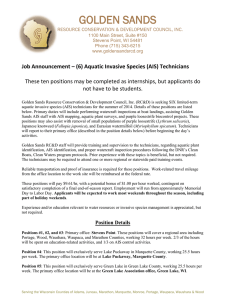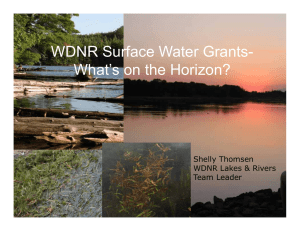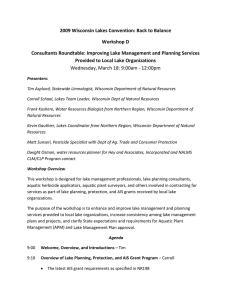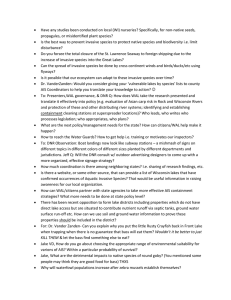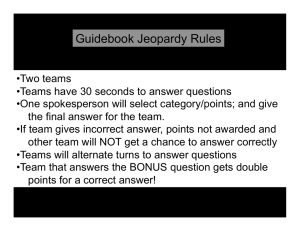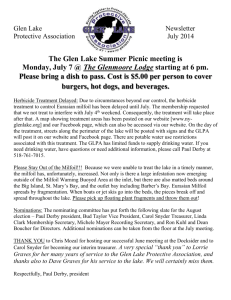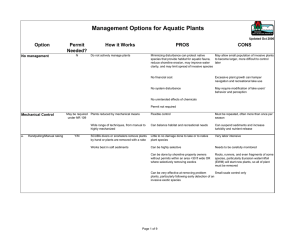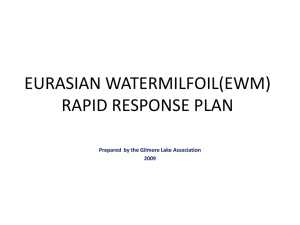Wisconsin’s Aquatic Invasive Species Program
advertisement
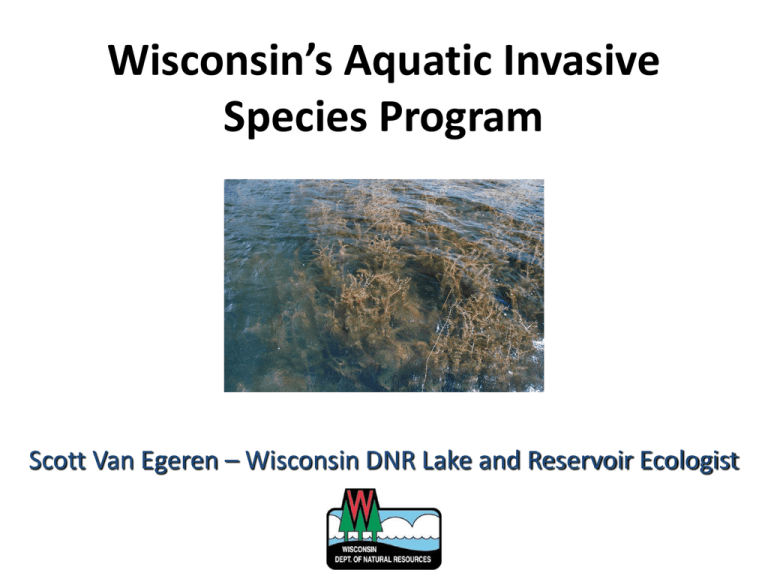
Wisconsin’s Aquatic Invasive Species Program Scott Van Egeren – Wisconsin DNR Lake and Reservoir Ecologist What is an “Invasive Species”? A nonnative species whose introduction causes or is likely to cause economic or environmental harm or harm to human health, and includes individual specimens, eggs, larvae, seeds, propagules and any other viable life-stages of such species. Why do we care? • Economic impacts – Fishing industry, tourism, property values • Ecological impacts – Native fish, invertebrates, plants • Recreational impacts – Boating, angling, swimming Wisconsin’s AIS Program • • • • • • Partnership Grants Prevention Monitoring Control Research Aquatic Invasive Species Grants • $4 million annually • DNR Aquatic Invasive Species grants – Education/Prevention/Planning – Control • Rapid Response • Established Population Control – Research Prevention Wisconsin Invasive Species Law Adm Code NR40 Monitoring Citizen scientists Professional Staff Research to aid management (~ $350,000/year) • AIS Prevention – Social marketing to change behavior – AIS decontamination methods – “Smart” prevention • AIS Control – Operational evaluation of EWM/CLP control – EWM biological control – rearing weevils and evaluating weevil stocking – Non-target impacts of AIS control • AIS Monitoring – Long-term EWM population dynamics – Tracking the rate of AIS spread • AIS Impacts – Spiny water flea - detection, vectors, impacts • Etc. Eurasian water-milfoil management • Grants and Technical Assistance Available • Operational research • Importance of Monitoring Lakes Partnership Technical Assistance • Guidance on APM/AIS Planning • Standardized monitoring to evaluate management APM Planning Checklist • • Set Goals Take inventory of your lake • • • • • • • • Develop management objectives needed to maintain beneficial ecological and recreational lake uses. • • Include prevention strategies for additional invasion Analysis of management alternatives • • • Aquatic Plant Management History Plant Survey Critical Areas of Fish and Wildlife Habitat Water Quality Areas of recreational use and restrictions Lake user perceptions of aquatic plant issues Watershed issues affecting plant growth Consider feasibility, efficacy and non-target/water quality impacts Discuss preferred recommendations with regional DNR APM Coordinator Develop a strategy for evaluating management • • • Aquatic plant data Water quality data Herbicide concentration data “both invasive and native species occurred at low densities in most locations where they were present.” A “Wait and See” Strategy can be an option Unmanaged Boot Manson Weber 2005 Little Bearskin Bear Paw 2006 Hancock 2007 2008 2009 2010 2011 2012 Nault et al. 2013 Much research has been done to find appropriate EWM control techniques Indoor Growth Chambers • Wide range of herbicide concentrations and exposure times (CET) • Replicated studies • Species sensitivity Outdoor Mesocosm Tanks We know the required exposure time for control Green & Westerdahl, 1990 JAPM 28:27-32 2000 ppb 1500 1000 500 Recommended label rate: 2.0 – 4.0 ppm (Hours) 1.0 ppm = 1.0 mg/L = 1000 ppb EWM Management Scenarios Whole Lake Large Scale Small Scale Amount of herbicide applied will have lakewide effects on plants (>0.1 ppm lakewide) Herbicide will be applied on a small scale where dissipation will not result in significant lakewide concentrations We know the required exposure time for control Green & Westerdahl, 1990 JAPM 28:27-32 2000 ppb 1500 1000 500 Recommended label rate: 2.0 – 4.0 ppm (Hours) 1.0 ppm = 1.0 mg/L = 1000 ppb Herbicide Monitoring Project Lakes Eurasian water-milfoil can become a problem, but management must be scaled appropriately Sandbar Lake, Bayfield County Photo by Frank Koshere Whole-lake treatments: Effective, but can be done too well. Tomahawk Sandbar Tomahawk Sandbar Nault et al., 2014. Lake & Res. 30:1-10 Whole-lake Treatment Milfoil Control 100 90 South Twin '10 Deep Pine Big Sand Focus area Kathan 80 Milfoil Control (%) Wilson Grass Sandbar '11 Sandbar '13 70 Forest '11 60 No control 50 Less than optimal control 30 EWM Forest '12 HWM English '10 Round South Twin '09 40 Tomahawk Frog Golden George Silver High level of control Damage to natives 20 English '12 10 0 Langford 0 0.1 Marion Millpond 0.2 0.3 0.4 0.5 Mean 2,4-D Concentration 0-7 DAT (ppm) 0.6 Nault et al. Concentration exposure time not great enough for plant control in spot treatments Green & Westerdahl, 1990 JAPM 28:27-32 2000 ppb 1500 1000 500 Small scale Treatments (Hours) Nault et al. There is a need other management options for smaller milfoil beds Other lake associations are trying manual removal with volunteer help. Contractors and sometimes volunteer divers are available to handpull deeper areas. Golden Sands RC&D has instructional materials for manual removal. EWM management take homes • • • • Eradication is not a realistic goal, unless a new population is discovered. No one management strategy alone will control and maintain low levels of AIS, while not causing other impacts. EWM is naturally variable from year to year – a wait and see strategy is a viable option. Whole-lake treatments effective at large reductions, but they can be overdone. • • • Small treatments (relative to lake size) appear to not hold appropriate herbicide concentration long enough. • • Flowing water problematic in getting appropriate concentration contact. Some clones of hybrid milfoil appear to be tolerant to commonly used herbicides. Additional maintenance strategies needed – hand pulling, suction harvesting, barriers for small treatments, bottom mats We are evaluating the toxicity of 2,4D to fish and aquatic insects – more to come in the future. Questions

